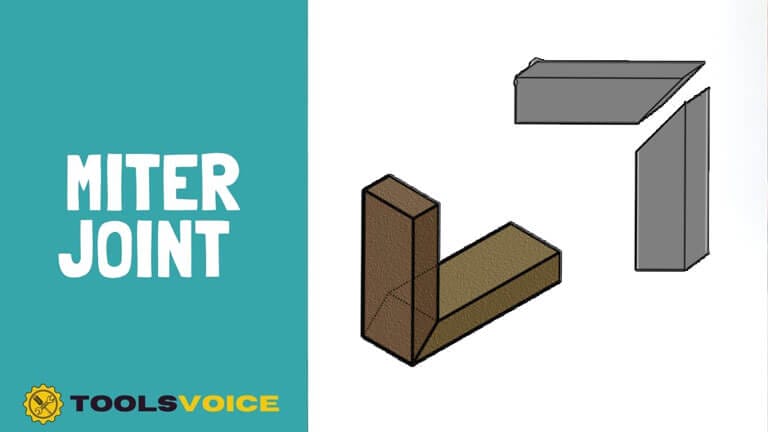The mitre joint, also called a corner joint or miter joint and It’s a type of butt joint that joins two pieces at their endpoints. The result is an angle that resembles the shape of a miter, hence the name.
A mitre joint can be used to join any two boards with different thicknesses and lengths, as long as they are oriented correctly relative to each other. Miter joints are often preferred over other methods for joining boards because they allow you to use the full length of each board.

However, it has a number of advantages and disadvantages. Let’s take a closer look at them!
Miter Joint Advantages
Easy to make
Miter joints are very easy to make. You can use a miter saw or a simple hand saw to cut the pieces of lumber at the desired angle. This makes them a popular choice for every woodworker.
Nice and clean appearance
Miter joints look very nice and give a clean, finished appearance to whatever project you are working on. This is because the joint is made up of two perfectly aligned pieces of lumber that meet at a perfect angle.
The two pieces of lumber are usually cut at a 45-degree angle and then glued and clamped in place.
Can be strong
Although miter joints are not as strong as other types of joints, they can be used to build strong structures in some cases.
Because there are some new variations such as the Dovetail miter joint, Lock miter joint, Mitered half-lap joint, Mitered coping joint, and so on. These joints are made up of two pieces that overlap & stick out at an angle and produce a durable miter joint.
No visible gaps
Miter joints are very accurate and precise. When they are made perfectly, there are no visible gaps between the two pieces of lumber. This makes them ideal for projects where precision is key, such as cabinet-making or installing baseboard & crown molding.
Lightweight Joint
Mitre joint can be made from a variety of materials including hardwood, softwood, and man-made products such as metal. Moreover, they are also used for large or small projects. There are no limitations!
Mitre Joint disadvantages
While there are plenty of benefits to using a miter joint in your project, there are also several drawbacks that should not be ignored when making decisions related to your woodworking projects. Let’s have a look at them now:
Experience & skill needed
Because mitre joints require a lot of precision and accuracy to make them look perfect, they are not ideal for beginners. You will need some experience under your belt before you can work on such projects with ease as it requires excellent craftsmanship skills.
Requires accurate measuring and cutting
In order to get accurate results, you need to take accurate measurements and cut the boards at exactly the right angle. If not, the joint will be too tight or loose. This can cause problems like gaps between pieces of lumber or small cracks in finished projects.
Not usable for wide boards
Mitre joints cannot be used on large boards because they are designed for smaller boards. You will need to use a butt joint instead if you are working with wide pieces of lumber for your project.

Can be Expensive
In order to make miter joints constantly, you will need access to some specialized tools such as a miter saw or chop saw.
Miter joints are not very difficult to make if you use a miter saw. Because miter saw makes accurate cuts and angles that allow your pieces of lumber to fit together perfectly every time. Without it, making mitre joints can be challenging.
Miter saws are expensive, so if you are just starting out in woodworking, you may not want to invest in this tool right away. You can still make mitre joints with a hand saw, but it will take more time and effort.
Gaps may form
Even if you are a skilled woodworker and take your time when making a miter joint, there is always a chance for small gaps to form between the two pieces of lumber. This can ruin the overall appearance of your project.
So, It’s important to use framing clamps and glue when making miter joints because it helps hold everything together while the glue dries.
Comparatively Weak Joint
Miters produce weaker joints than most other types of woodworking joints which is why they are not recommended for use in areas that will be put under a lot of stress.
If you are using them in a project that will be subject to heavy loads, you should beef up the joint with dowels or screws.
No interlocking mechanism
Miter joints have no interlocking mechanism so they cannot be joined together in different ways, as long as the end points match each other and lie at the same angle. This lack of flexibility makes them less versatile than some other types of joints.
Doesn’t fit on circles
Mitre joints are not very good for making cuts in materials that require a circular cut. This is because the angle of the cut will be difficult to make perfect and you may end up with an uneven or poorly-shaped piece of lumber.
Final Verdict
So, what’s the verdict? Are miter joints worth using in your next woodworking project?
Overall, miter joints have a lot to offer in terms of benefits – they look great, are easy to make, and can be strong if done correctly. That’s why they are highly used in making picture frames and face frames of kitchen cabinets or other furniture.
However, they are not recommended for use in areas that will be highly stressed and require advanced skills to make them look perfect.
Miter joints are a great option if you know what they are capable of and can work around their limitations!

i am a huge fan of wood videos when my dog died i watched joint videos to make me feel better because the alternative was turning back to opiods you changed my life thank you i love wood joints 4ever